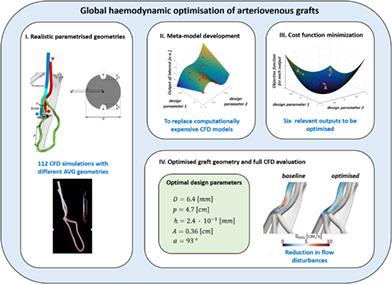当前位置:
X-MOL 学术
›
Int. J. Numer. Method. Biomed. Eng.
›
论文详情
Our official English website, www.x-mol.net, welcomes your
feedback! (Note: you will need to create a separate account there.)
Haemodynamic optimisation of a dialysis graft design using a global optimisation approach
International Journal for Numerical Methods in Biomedical Engineering ( IF 2.2 ) Pub Date : 2020-11-29 , DOI: 10.1002/cnm.3423 Sjeng Quicken 1, 2 , Tammo Delhaas 1 , Barend M E Mees 3 , Wouter Huberts 1, 2
International Journal for Numerical Methods in Biomedical Engineering ( IF 2.2 ) Pub Date : 2020-11-29 , DOI: 10.1002/cnm.3423 Sjeng Quicken 1, 2 , Tammo Delhaas 1 , Barend M E Mees 3 , Wouter Huberts 1, 2
Affiliation

|
Disturbed flow and the resulting non‐physiological wall shear stress (WSS) at the graft‐vein anastomosis play an important role in arteriovenous graft (AVG) patency loss. Modifying graft geometry with helical features is a popular approach to minimise the occurrence of detrimental haemodynamics and to potentially increase graft longevity. Haemodynamic optimisation of AVGs typically requires many computationally expensive computational fluid dynamics (CFD) simulations to evaluate haemodynamic performance of different graft designs. In this study, we aimed to develop a haemodynamically optimised AVG by using an efficient meta‐modelling approach. A training dataset containing CFD evaluations of 103 graft designs with helical features was used to develop computationally low‐cost meta‐models for haemodynamic metrics related to graft dysfunction. During optimisation, the meta‐models replaced CFD simulations that were otherwise needed to evaluate the haemodynamic performance of possible graft designs. After optimisation, haemodynamic performance of the optimised graft design was verified using a CFD simulation. The obtained optimised graft design contained both a helical graft centreline and helical ridge. Using the optimised design, the magnitude of flow disturbances and the size of the anastomotic areas exposed to non‐physiological WSS was successfully reduced compared to a regular straight graft. Our meta‐modelling approach allowed to reduce the total number of CFD model evaluations required for our design optimisation by approximately a factor 2000. The applied efficient meta‐modelling technique was successful in identifying an optimal, helical graft design at relatively low computational costs. Future studies should evaluate the in vivo benefits of the developed graft design.
中文翻译:

使用全局优化方法对透析移植物设计进行血流动力学优化
受干扰的血流和由此产生的移植静脉吻合处的非生理壁剪切应力 (WSS) 在动静脉移植 (AVG) 通畅性丧失中起着重要作用。用螺旋特征修改移植物几何形状是一种流行的方法,可以最大限度地减少有害血流动力学的发生并可能增加移植物的寿命。AVG 的血液动力学优化通常需要许多计算成本高昂的计算流体动力学 (CFD) 模拟来评估不同移植物设计的血液动力学性能。在这项研究中,我们旨在通过使用有效的元建模方法开发血液动力学优化的 AVG。一个训练数据集包含 103 种具有螺旋特征的移植物设计的 CFD 评估,用于开发与移植物功能障碍相关的血流动力学指标的计算成本低的元模型。在优化过程中,元模型取代了评估可能的移植物设计的血液动力学性能所需的 CFD 模拟。优化后,使用 CFD 模拟验证优化的移植物设计的血液动力学性能。获得的优化移植设计包含螺旋移植中心线和螺旋脊。使用优化设计,与常规直线移植物相比,流动扰动的幅度和暴露于非生理性 WSS 的吻合区域的大小成功减少。我们的元建模方法允许将我们的设计优化所需的 CFD 模型评估总数减少大约 2000 倍。应用的高效元建模技术成功地确定了最佳的、以相对较低的计算成本进行螺旋移植设计。未来的研究应该评估开发的移植设计的体内益处。
更新日期:2020-11-29
中文翻译:

使用全局优化方法对透析移植物设计进行血流动力学优化
受干扰的血流和由此产生的移植静脉吻合处的非生理壁剪切应力 (WSS) 在动静脉移植 (AVG) 通畅性丧失中起着重要作用。用螺旋特征修改移植物几何形状是一种流行的方法,可以最大限度地减少有害血流动力学的发生并可能增加移植物的寿命。AVG 的血液动力学优化通常需要许多计算成本高昂的计算流体动力学 (CFD) 模拟来评估不同移植物设计的血液动力学性能。在这项研究中,我们旨在通过使用有效的元建模方法开发血液动力学优化的 AVG。一个训练数据集包含 103 种具有螺旋特征的移植物设计的 CFD 评估,用于开发与移植物功能障碍相关的血流动力学指标的计算成本低的元模型。在优化过程中,元模型取代了评估可能的移植物设计的血液动力学性能所需的 CFD 模拟。优化后,使用 CFD 模拟验证优化的移植物设计的血液动力学性能。获得的优化移植设计包含螺旋移植中心线和螺旋脊。使用优化设计,与常规直线移植物相比,流动扰动的幅度和暴露于非生理性 WSS 的吻合区域的大小成功减少。我们的元建模方法允许将我们的设计优化所需的 CFD 模型评估总数减少大约 2000 倍。应用的高效元建模技术成功地确定了最佳的、以相对较低的计算成本进行螺旋移植设计。未来的研究应该评估开发的移植设计的体内益处。











































 京公网安备 11010802027423号
京公网安备 11010802027423号